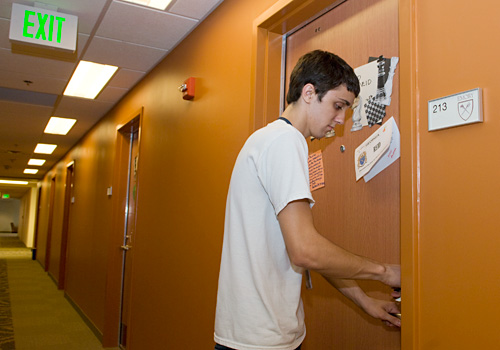Autumn 2008: Sustainable Efforts

key to conservation: Reid Turner 10OX checks out his room in the new East Village, which helped Emory earn a spot on the Green Rating Honor Roll.
Jon Rou
LEEDing the Green Pack
As first-year students at Oxford College unpacked their bags in their new East Village Residential Complex rooms, they were already making a sustainable statement—moving into the “greenest” dorm on the University’s historic campus.
Emory has been selected for Princeton Review’s 2009 Green Rating Honor Roll, a list honoring eleven colleges and universities that each received the highest scores under the Review’s new “green rating” of colleges. The University was included for having more square feet of green construction, including Leadership in Energy and Environmental Design (LEED)–certified buildings, than any other U.S. campus.
Emory’s Board of Trustees prioritized sustainable building and LEED certification (the national marker for green construction) in 2002. The latest buildings on campus built to LEED standards include the new Candler School of Theology and Center for Ethics building, the new Oxford residence halls, and the Few and Evans Residence Halls at Emory.
Emory also was honored for integrating sustainability into the curriculum (including the longest-running faculty development programs in sustainability in the country), promoting alternative transportation with a shuttle fleet that is 100 percent alternatively fueled, recycling Emory’s waste stream (with a goal of 65 percent by 2015), and providing local and sustainably grown food.
The ranking included 534 schools that provided data from surveys during the 2007–2008 academic year concerning their environmentally related policies, practices, and academic offerings.
Criteria included: whether students have a campus quality of life that is healthy and sustainable; how well the school is preparing students for employment and citizenship in a world defined by environmental challenges; and the school’s overall commitment to environmental issues. A sampling of the sustainable metrics in the surveys included energy use, recycling, food, buildings, transportation, and academic offerings.